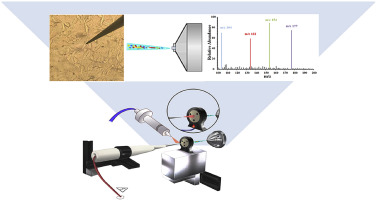Our official English website, www.x-mol.net, welcomes your
feedback! (Note: you will need to create a separate account there.)
In situ analysis of single cell and biological samples with rGO-Cu functional probe ESI-MS spectrometry.
Talanta ( IF 5.6 ) Pub Date : 2020-01-15 , DOI: 10.1016/j.talanta.2020.120751 Yan Zheng 1 , Zhiqiang Liu 1 , Junpeng Xing 1 , Zhong Zheng 1 , Zifeng Pi 1 , Fengrui Song 1 , Shu Liu 1
Talanta ( IF 5.6 ) Pub Date : 2020-01-15 , DOI: 10.1016/j.talanta.2020.120751 Yan Zheng 1 , Zhiqiang Liu 1 , Junpeng Xing 1 , Zhong Zheng 1 , Zifeng Pi 1 , Fengrui Song 1 , Shu Liu 1
Affiliation

|
At present, probe electrospray ionization mass spectrometry is widely used in the single cell analysis. As the continuous expansion of requirements for detecting more metabolite species from single cells, the sensitivity and accuracy of the instrument and the enrichment capacity of the probes are in high demand. Therefore, a high efficiency functional probe electrospray ionization mass spectrometry (FPESI-MS) analysis platform is established. In this platform, nitrogen aggregation/gas heating system and reduced graphene oxide functional copper probe (rGO-Cu probe) are firstly reported. The nitrogen aggregation/gas heating system can promote desorption of the analytes from probe and aggregate the product ions into the ion cluster to increase the ion transport capacity and the detection efficiency. rGO-Cu probe formed huge specific surface area to enrich the analytes without sacrificing the electrical conductivity. The probe substrates were prepared by electrochemical etching, after rGO-functionalization, the tip diameter of all kinds of the probes were measured to be less than 100 nm, which is much smaller than the PC12 single cells. Graphene oxide cannot be completely reduced by electrochemical methods, thus the rGO-Cu probe can enrich the analytes through the huge surface area of the graphene thin layer, as well as the hydrogen bond and the electrostatic absorption of the surface oxygen-containing groups. Seven AD related neurotransmitters and sixteen biomarkers in PC12 single cells and twelve metabolites in serum of AD rats were successfully analyzed by using FPESI-MS, and this method is expected to be used in the rapid detection of metabolites in biological samples and living organism.
中文翻译:

用rGO-Cu功能探针ESI-MS光谱原位分析单细胞和生物样品。
目前,探针电喷雾电离质谱已广泛用于单细胞分析中。随着从单细胞检测更多代谢物种类的需求不断扩大,对仪器的灵敏度和准确性以及探针的富集能力提出了更高的要求。因此,建立了高效功能探针电喷雾电离质谱(FPESI-MS)分析平台。在该平台上,首先报道了氮聚集/气体加热系统和还原型氧化石墨烯功能铜探针(rGO-Cu探针)。氮气聚集/气体加热系统可以促进分析物从探针上的解吸,并将产物离子聚集到离子簇中,从而提高离子传输能力和检测效率。rGO-Cu探针形成了巨大的比表面积,可在不牺牲电导率的情况下富集分析物。通过电化学蚀刻制备探针基板,在rGO功能化后,测得各种探针的尖端直径均小于100 nm,远小于PC12单细胞。氧化石墨烯不能通过电化学方法完全还原,因此rGO-Cu探针可以通过石墨烯薄层的巨大表面积以及氢键和表面含氧基团的静电吸收来富集分析物。使用FPESI-MS成功分析了AD大鼠PC12单细胞中的7种与AD有关的神经递质和16种生物标志物,以及血清中的12种代谢物,
更新日期:2020-01-15
中文翻译:

用rGO-Cu功能探针ESI-MS光谱原位分析单细胞和生物样品。
目前,探针电喷雾电离质谱已广泛用于单细胞分析中。随着从单细胞检测更多代谢物种类的需求不断扩大,对仪器的灵敏度和准确性以及探针的富集能力提出了更高的要求。因此,建立了高效功能探针电喷雾电离质谱(FPESI-MS)分析平台。在该平台上,首先报道了氮聚集/气体加热系统和还原型氧化石墨烯功能铜探针(rGO-Cu探针)。氮气聚集/气体加热系统可以促进分析物从探针上的解吸,并将产物离子聚集到离子簇中,从而提高离子传输能力和检测效率。rGO-Cu探针形成了巨大的比表面积,可在不牺牲电导率的情况下富集分析物。通过电化学蚀刻制备探针基板,在rGO功能化后,测得各种探针的尖端直径均小于100 nm,远小于PC12单细胞。氧化石墨烯不能通过电化学方法完全还原,因此rGO-Cu探针可以通过石墨烯薄层的巨大表面积以及氢键和表面含氧基团的静电吸收来富集分析物。使用FPESI-MS成功分析了AD大鼠PC12单细胞中的7种与AD有关的神经递质和16种生物标志物,以及血清中的12种代谢物,











































 京公网安备 11010802027423号
京公网安备 11010802027423号